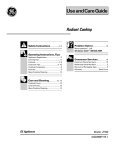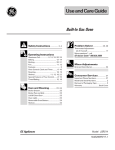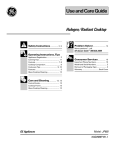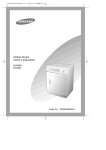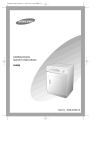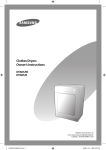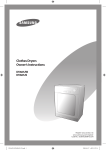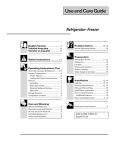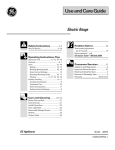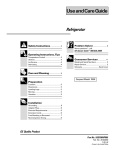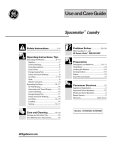Download GE DSKP233EWWH Electric Portable Dryer
Transcript
UseandCareGuide Spacemaker™ Dryer Safety Instructions ....................3–5 Problem Solver .......................11–13 More questions ?…call GE Answer Center® 800.626.2000 Operating Instructions, Tips Accessory Kit ...................................................5 Automatic Drying ...........................................7 Control Setting Guide ....................................7 Cycle Settings .............................................7, 8 Energy-Saving Tips.........................................5 Knits Drying Tips .....................................7, 12 Lint Filter...................................................4, 6 Loading.........................................................6, 9 Operating the Dryer ..................................6–9 Permanent Press Drying Tips .......7, 12, 13 Sorting Clothes...........................................6, 9 Special Drying Instructions ..........................8 Timed Drying ...................................................7 Care and Cleaning Dryer Exhaust................................................10 Exterior ...........................................................10 Lint Filter ........................................................10 Storing the Dryer..........................................10 User Maintenance Instructions................10 GE Appliances Consumer Services ...................15 Appliance Registration..................................2 Important Phone Numbers........................15 Model and Serial Numbers ..........................2 Warranty ........................................Back Cover Model: DSKP233ET HELP US HELP YOU… Read this book carefully. Save time and money. It is intended to help you operate and maintain your new dryer properly. Keep it handy for answers to your questions. If you don’t understand something or need more help, call: GE Answer Center® 800.626.2000 24 hours a day, 7 days a week. Before you request service… check the Problem Solver section. It lists causes of minor operating problems that you can correct yourself. If you received a damaged dryer… Immediately contact the dealer (or builder) that sold you the dryer. Write down the model and serial numbers. You’ll find them on a label on the front of the dryer behind the door. These numbers are also on the Consumer Product Ownership Registration Card that came with your dryer. Before sending in this card, please write these numbers here: Model Number Serial Number Use these numbers in any correspondence or service calls concerning your dryer. WARNING: For your safety the information in this manual must be followed to minimize the risk of fire or explosion or to prevent property damage, personal injury or loss of life. —Do not store or use gasoline or other flammable vapors and liquids in the vicinity of this or any other appliance. —WHAT TO DO IF YOU SMELL GAS • Do not try to light any appliance. • Do not touch any electrical switch; do not use any phone in your building. • Clear the room, building or area of all occupants. • Immediately call your gas supplier from a neighbor’s phone. Follow the gas supplier’s instructions. • If you cannot reach your gas supplier, call the fire department. —Installation and service must be performed by a qualified installer, service agency or the gas supplier. All drying instruction terms in this book conform to the Care Labeling Rule established by the Federal Trade Commission, January 1984. If you need service To obtain service, see the Consumer Services page in the back of this book. We’re proud of our service and want you to be pleased. If for some reason you are not happy with the service you receive, here are three steps to follow for further help. FIRST, contact the people who serviced your appliance. Explain why you are not pleased. In most cases, this will solve the problem. 2 NEXT, if you are still not pleased, write all the details—including your phone number—to: Manager, Consumer Relations GE Appliances, Appliance Park Louisville, KY 40225 FINALLY, if your problem is still not resolved, write: Major Appliance Consumer Action Panel 20 North Wacker Drive Chicago, IL 60606 IMPORTANT SAFETY INSTRUCTIONS Read all instructions before using this appliance. IMPORTANT SAFETY NOTICE Warning—To reduce the risk of fire, electric shock, or injury to persons when using your appliance, follow basic precautions, including the following: • Use this appliance only for its intended purpose as described in this Use and Care Book. • This dryer must be properly installed and located in accordance with the Installation Instructions before it is used. If you did not receive an Installation Instructions sheet with your dryer, you can obtain one by calling, toll free, the GE Answer Center®, 800.626.2000. —Properly ground to conform with all governing codes and ordinances. Follow details in Installation Instructions. —Locate where the temperature is above 50°F. (10°C.) for satisfactory operation of the dryer control system. Do not install or store the dryer where it will be exposed to the weather. —Connect to a properly rated, protected and sized power supply circuit to avoid electrical overload. —Exhausting to the outside is STRONGLY RECOMMENDED to prevent large amounts of moisture and lint from being blown into the room. Carefully follow the Exhausting Details in the Installation Instructions. If your dryer is not exhausted to the outside, see the Care and Cleaning section. • When disconnecting this appliance pull by the plug rather than the cord to avoid damage to the cord or junction of cord and plug. Make sure that the cord is located so that it will not be stepped on, tripped over or otherwise subjected to damage or stress. To Minimize the Possibility of a Fire Hazard • Exhaust Duct—See Installation Instructions. Use only rigid metal or flexible metal 4″ diameter ductwork inside the dryer cabinet or for exhausting to the outside. USE OF PLASTIC OR OTHER COMBUSTIBLE DUCTWORK CAN CAUSE A FIRE. PUNCTURED DUCTWORK CAN CAUSE A FIRE IF IT COLLAPSES OR BECOMES OTHERWISE RESTRICTED IN USE OR DURING INSTALLATION. • Do not dry articles containing rubber, plastic, or similar materials (such as padded bras, tennis shoes, galoshes, bath mats, rugs, bibs, baby pants, plastic bags, etc.) as these materials may melt or burn. Also, some rubber materials, when heated, can under certain circumstances produce fire by spontaneous combustion. • Do not store items that may burn or melt (such as clothing, paper material, plastics or plastic containers, etc.) on top of the dryer during operation. (continued next page) 3 Important Safety Instructions The California Safe Drinking Water and Toxic Enforcement Act requires the governor of California to publish a list of substances known to the state to cause cancer, birth defects or other reproductive harm and requires businesses to warn customers of potential exposure to such substances. Gas appliances can cause minor exposure to four of these substances, namely benzene, carbon monoxide, formaldehyde and soot, caused primarily by the incomplete combustion of natural gas or LP fuels. Properly adjusted dryers will minimize incomplete combustion. Exposure to these substances can be minimized further by properly venting the dryers to the outdoors. • Do not repair or replace any part of the appliance or attempt any servicing unless specifically recommended in this Use and Care Book or in published user-repair instructions that you understand and have the skills to carry out. IMPORTANT SAFETY INSTRUCTIONS (continued) • Garments labeled “Dry Away from Heat” (such as life jackets containing Kapok) must not be put in your dryer. • Do not wash or dry articles that have been cleaned in, washed in, soaked in, or spotted with combustible or explosive substances (such as wax, paint, gasoline, degreasers, dry-cleaning solvents, kerosene, etc.) which may ignite or explode. Do not add these substances to the wash water. Do not use these substances around your washer and/or dryer during operation. • Any article on which you have used a cleaning solvent, or which contains flammable materials (such as cleaning cloths, mops, towels used in beauty salons, restaurants or barber shops, etc.) must not be placed in or near the dryer until all traces of these flammable liquids or solids and their fumes have been removed. There are many highly flammable items used in homes such as: acetone, denatured alcohol, gasoline, kerosene, some household cleaners, some spot removers, turpentines, waxes, wax removers and products containing petroleum distillates. • Clean the lint filter before each load to prevent lint accumulation inside the dryer or in the room. DO NOT OPERATE THE DRYER WITHOUT THE LINT FILTER IN PLACE. • Keep the area around and underneath your appliances free from the accumulation of combustible materials, such as lint, paper, rags, chemicals, etc. • The interior of the machine and the exhaust duct connection inside the dryer should be cleaned periodically by a qualified individual. To Minimize the Possibility of Injury • Never reach into the dryer while the drum is moving. Before loading, unloading or adding clothes, wait until the drum has completely stopped. • Do not dry fiberglass articles in your dryer. Skin irritation could result from the remaining glass particles that may be picked up by clothing during subsequent dryer uses. • The laundry process can reduce the flame retardancy of fabrics. To avoid such a result, the garment manufacturer’s care instructions should be followed very carefully. • Close supervision is necessary if this appliance is used by or near children. Do not allow children to play inside, on, or with this appliance or any discarded appliance. Dispose of discarded appliances and shipping or packing materials properly. Before discarding a dryer, or removing from service, remove the door of the dryer compartment. • Keep all laundry aids (such as detergents, bleaches, fabric softeners, etc.) out of the reach of children, preferably in a locked cabinet. Observe all warnings on container labels to avoid personal injury. • Keep the floor around your appliances clean and dry to reduce the possibility of slipping. • To minimize the possibility of electric shock, unplug this appliance from the power supply before attempting any maintenance or cleaning (except the removal and cleaning of the lint filter). NOTE: Turning the Cycle Selector knob to an OFF position does NOT disconnect the appliance from the power supply. • Do not tamper with the controls. 4 Dryer-applied Fabric Softeners or Anti-static Conditioners You may wish to soften your laundered fabrics or reduce the static electricity in them. We recommend you use either a fabric softener in the wash cycle, according to the manufacturer’s instructions for those products, or try a dryer-added product for which the manufacturer gives written assurance on the package that their product can be safely used in your dryer. Service or performance problems caused by the use of these products are the responsibility of the manufacturers of those products and are not covered under the warranty of this appliance. Energy-Saving Tips SAVE THESE INSTRUCTIONS Important Safety Instructions • Do not operate this appliance if it is damaged, malfunctioning, partially disassembled, or has missing or broken parts, including a damaged cord or plug. • Never climb on or stand on the dryer top. • If yours is a gas dryer, it is equipped with an automatic electric ignition and does not have a pilot light. DO NOT ATTEMPT TO LIGHT WITH A MATCH. Burns may result from having your hand in the vicinity of the burner when the automatic ignition may turn on. ENERGY-SAVING TIPS • Sort clothes by weight so you won’t have to run an extra cycle for one or two heavier, slower-drying items. • Do not overload your dryer. For efficient drying, clothes need to tumble freely. • Remove garments promptly at the end of the drying cycle and place on hangers. • Dry your clothes in consecutive loads. Using a “warm” dryer will save energy. • Clean the dryer lint filter each time you dry. • Clean the dryer exhaust ducting at least once a year. A partially clogged exhaust can lengthen drying time. Optional Accessories OPTIONAL ACCESSORIES Accessory kits are available for installing the dryer in a rack above the washer. See your dealer or call 800.626.2000 for accessory kit information. 5 HOW TO OPERATE YOUR DRYER WARNING—To reduce the risk of fire, electric shock, or injury to persons, read the IMPORTANT SAFETY INSTRUCTIONS before operating this appliance. 75 60 ING RY 90 1 05 D O F O F F RE S/ G. O F F A 10 IR 2 E OR M Push To Start PERM. PR ES Spacemaker Dryer LESS 15 30 F TIM 45 ED ENERGY PREFERRED AUTOMATIC SETTING 1 Check the Lint Filter Clean the lint filter each time the dryer is used. Always be sure the lint filter is in place. Do not run the dryer with the lint screen loose, damaged, blocked or missing. Doing so can cause overheating, damage fabrics and be a fire hazard. The lint screen is located inside the dryer drum, on the back wall. To clean: 1. Use the finger holes to pull the lint screen straight out. Pull straight out 2. Lightly squeeze the body as shown while pulling the cover off. 3. ROLL lint off the screen with your fingers. Do not rinse or wash the screen. 4. Replace the cover on the body of the lint screen. Squeeze body; 5. Before replacing the lint screen, pull cover off remove any lint from the wire mesh on the back wall (behind the lint screen). 6. Push the lint screen straight back until it snaps into place. Sort and Load the Clothes Good sorting for the dryer begins at the washer. Generally, if clothes are sorted right for washing, they’re sorted right for drying. See the How to Sort the Clothes section. If you do mix various types of fabrics in your load, set the controls for the lighter-weight fabrics and remove when dry. Reset controls for the remaining heavier fabrics Set the Controls See the Suggested Fabric and Drying Selections guide. 1 Cycle Selector. Turn the Cycle Selector to the desired cycle setting. The selector may be turned in either direction. 2 Start Button. Press the Start button to start the dryer. (Opening the door during operation stops the dryer. To restart, close the door and press the Start button.) NOTE: Drying times will vary according to the type of heat used (electric, natural gas or LP gas), size of load, types of fabrics, wetness of clothes and condition of exhaust ducts. 6 Polyester Knits & Permanent Press Drying Tips • REMOVE CLOTHES PROMPTLY—To help prevent wrinkling, remove clothes from the dryer promptly at the end of the drying cycles. • DO NOT OVERLOAD— Garments being dried or dewrinkled should tumble freely. • PLACE ON HANGERS— Permanent press and polyester knit garments look best if placed on hangers after drying. The Difference Between Automatic, Timed and Air Drying Automatic Drying Drying Selections Guide for the Automatic Cycles O F F ENERGY PREFERRED AUTOMATIC SETTING E OR M RE S/ G. O F F A1 IR F LESS • For loads that include heavyweight fabrics. • If you desire to remove more moisture. PERM. PR ES F F MORE A IR . RM G S • Energy preferred automatic setting. • For most normal loads. 10 D N SS LE MOR E O F O ENERGY PREFERRED AUTOMATIC SETTING O F M. PRESS/RE PER G. F SS/REG. PRE 10 AI R PE O F F YI DR ENERGY PREFERRED AUTOMATIC SETTING Set toward Less Dry Set toward More Dry Set to ASTERISK Position • For light weight fabric loads. • If you desire to remove less moisture. • For very small loads. End of Cycle Signal This operates with any cycle. The signal will sound just before the end of the cycle to remind you to remove the clothes. 7 How to Operate Your Dryer The Automatic cycles use a solid sensing device, located on the back of the dryer drum, to measure the amount of moisture in the load. The sensor “feels” the moisture in items as they tumble over it. As the items begin to dry, the moisture level drops. When the proper degree of dryness is sensed, the timer advances into a gentle heat, then cools down. Timed Drying. When using the Timed Cycles, you select the number of minutes you wish the dryer to run and it turns off at the end of this time period. The last 5 minutes of this cycle are without heat. This helps make the load easier to handle. Air Cycle. The dryer does not heat when the Cycle Control knob is set on AIR. This cycle can be used to fluff or air dry bedding, plastic tablecloths, foam rubber pillows, stuffed toys, sneakers, etc. Do not dry plastic or rubber items with heat. Use AIR setting, or line dry. Failure to do so could result in fire or damaged items. SUGGESTED FABRIC AND DRYING SELECTIONS Cycle Suggested For Clothes Load/Fabrics such as: Air • Sheer curtains Perm. Press/Reg. • Cottons and linens • Down-filled garments, if machine washing and drying is recommended • Permanent Press fabrics with cotton • Synthetics Timed • Pillows* The terms High, Medium and Low Heat are those usually found on fabric care labels. For best results, follow your specific fabric care label. Special Instructions Refer to garment manufacturer’s care labels for more information. *Pillows 8 Check ticking for holes or weak seams where feathers or filling could escape. DRY ONLY ONE PILLOW AT A TIME. Set dryer for maximum time. Stop dryer occasionally and shake pillow to redistribute filling for more even drying. Check pillow at end of drying time—if not completely dry, return pillow to dryer and reset for more drying time. Feather pillows dry very slowly and must be dried completely to prevent mildew. DO NOT tumble dry pillows containing kapok. Sort by Surface Texture LINT PRODUCERS—such as terry toweling and chenille—give up lint. LINT COLLECTORS—such as man-made fibers and napped fabrics like velveteen and corduroy—attract lint. These must be dried separately. Separate Lint Producers from Lint Collectors Sort by Fabric Separate Cottons & Linens from Synthetics, Blends & Poly Knits from Permanent Press from Delicates In addition to sorting to reduce lint collection, we recommend that you wash fabrics of similar construction together whenever possible. Operating Instructions HOW TO SORT CLOTHES Sort by Color Whites from Lights from Darks from Sorting Separate NonColorfast Sort by Weight For more information, see the Special Drying Instructions section. Separate Heavy Items (such as towels) from Light Items (such as curtains) How to Load Your Dryer For best results, dry only articles of the same or similar type fabric in a single load. Never overload the dryer. The drum should be no more than 1/2 full of wet articles. Overloading prolongs drying time and produces uneven drying. Loading 9 CARE AND CLEANING User Maintenance Instructions • To keep your dryer looking good, wipe cabinet with a damp cloth. Occasionally wash it with mild soap and water and then apply a light coat of appliance polish to help preserve the finish. • Clean the lint filter before every load. • Keep area around and underneath your appliance free from the accumulation of combustible materials, such as lint, paper, rags, chemicals, etc. • Keep the floor around your appliances clean and dry to reduce the possibility of slipping. • Do not store dryer where it will be exposed to the weather. • If your dryer is exhausted to the outside, inspect and clean dryer exhaust ducting at least once a year. Dryer If your dryer is exhausted to the outside, inspect and clean the dryer exhaust ducting at least once a year. A clothes dryer produces combustible lint. When the dryer is not exhausted to the outside, this lint is more apt to accumulate in and near the dryer, which could create a fire hazard. How to reduce the possibility of a fire hazard, if your dryer (gas dryers must be exhausted outside) is not exhausted to the outside: • Clean the lint filter before every load. See How to Operate Your Dryer section. Lint can gather inside the dryer and create a FIRE HAZARD. This lint should be removed at least every 2 or 3 years, or more often, depending on dryer usage. 10 Electrical Shock and Personal Injury Hazard • Unplug the power supply cord or turn off the electrical power. • Do not put hands inside the cabinet. • Make sure the dryer is cool. • More than one person is required to lift, tilt or move the washer/dryer because of its weight and size. Failure to do so could result in electrical shock, injury or damage. Cleaning should be done only by a qualified person. 1. Unplug unit from electrical supply or turn off electrical power. 2. Remove back panel from dryer. (See Installation Instructions.) 3. Avoid touching wires and thermostats. 4. Remove lint from boxed-in area with a soft brush or vacuum cleaner. 5. Replace back panel, reconnect and level the appliance. Special Drying Instructions QUESTIONS? USE THIS PROBLEM SOLVER DRYER WON’T START • Dryer unplugged. Make sure power cord is plugged in. • No power to dryer. Check fuses and circuit breakers to make sure dryer is getting current. • Controls improperly set. Make sure controls are set and the Start button is pushed. Opening the door during operation stops the dryer. To restart, close the door and push the Start button. • Dryer door is open. Close door securely—dryer will not run with door open. • Circuit is overloaded. Do not operate other appliances on the same electrical outlet or circuit while the dryer is operating. • If dryer still does not operate, call for service. CLOTHES TAKE TOO LONG TO DRY • Controls improperly set. Check all controls to make sure they are correctly set for the load you want to dry. See the How to Operate Your Dryer section. • Clogged lint filter. Remove and clean filter before every load. See the Clean the Lint Filter section. • Improper ducting. Make sure dryer is ducted in accordance with the Installation Instructions. • Obstruction in exhaust ducting. Make sure ducting is clean and free of obstruction; make sure damper in outside wall cap operates easily. If flexible ducting is used, be sure it is not kinked and is properly installed according to the Installation Instructions. • Blown fuses or tripped circuit breakers. Check household fuses or circuit breakers. • Improper sorting. Do not mix heavy, hard-to-dry items with lightweight articles. • Large loads of moisture-holding fabrics, such as beach towels, take a long time to remove moisture. • Too many items in dryer. Dry only one washer load at a time. Do not combine loads. • Too few items in dryer. If drying only one article, add two more similar articles, even if dry, to insure proper tumbling. • When dryer is operating on a 120-volt circuit, longer drying times are normal. The drying on this circuit takes about three times as long as on a 240-volt circuit. • Excessively wet clothes. Check washer; it may be malfunctioning. SHRINKAGE, GENERAL • Some fabrics will shrink whether machine washed and tumble dried or washed by hand and drip dried; others may be safely washed but will shrink in a dryer. Follow garment manufacturers’ care labels exactly. If in doubt, do not machine wash or tumble dry. (continued next page) 11 The Problem Solver POSSIBLE CAUSE Care and Cleaning PROBLEM THE PROBLEM SOLVER (continued) PROBLEM POSSIBLE CAUSE SHRINKAGE, KNITS • Relaxation shrinkage can occur in knit fabrics that have been improperly stretched and elongated by the manufacturer. When this occurs, garment may be pressed back into shape after each wash and dry cycle. • Progressive or delayed shrinkage is caused when starch or sizing (in some fabrics) is gradually removed by laundering. May be noticed in older garments that have been laundered many times without previous shrinkage. Treat as for relaxation shrinkage above. • Shrinkage caused by overheating occurs in certain knit fabrics that have been heat-shaped. When washing, drying or ironing temperatures exceed the temperatures used to shape set, shrinkage may occur. This cannot be corrected, but it can be prevented by washing in cold or warm water; drying on low heat. WRINKLING IN PERMANENT PRESS AND “NO-IRON” ITEMS • Leaving clothes in dryer after tumbling stops. Remove clothes promptly and hang them immediately. • Too many items in dryer. Dry only one washer load at a time. Do not combine loads. • Too few items in dryer. If drying only one article, add two or more similar articles, even if dry, to insure proper tumbling. • Improper loads. Avoid laundering heavy permanent press items, such as work clothes, with lighter permanent press items, such as shirts or blouses. Do not wash or dry permanent press with regular laundry. • Too many clothes in washer. Items must have room to move freely. Permanent press loads should always be smaller than regular loads…no more than medium loads. • Use of incorrect wash and dry cycles. If available, use Permanent Press wash cycle which provides a cool-down rinse to minimize wrinkling. Also, if available, use Permanent Press drying cycle. • Incorrect water level. Use large water level for medium load; medium level or half full for small load. • Washing repeatedly in too hot water. Wash in cool or warm water with plenty of detergent. • Accumulation of lime scale due to use of carbonate detergents. If you must use a non-phosphate detergent, avoid the use of a high-carbonate detergent. • Failure to use fabric softener. Proper use of fabric softener will minimize wrinkling. 12 PROBLEM POSSIBLE CAUSE TO REMOVE WRINKLES ON DRYERS WITH A PERMANENT PRESS SETTING TO REMOVE WRINKLES: • Retumble on Perm. Press/Reg setting. • Rerinse and dry on Perm. Press/Reg setting. • If unsuccessful, retumble on normal temperature for 10–12 minutes and hang immediately. • Iron carefully. • Send to Dry Cleaners for pressing. • Some wrinkles may remain which cannot be removed.* * NOTE: If you follow good laundry procedures and permanent press clothes still come out wrinkled, the finish may not be good quality. Also, in permanent press synthetic/cotton blends, the cotton portion of the fabric can eventually wear away leaving only the synthetic. Since its the cotton portion which is treated for permanent press, a loss or decrease of permanent press performance will result. The Problem Solver If you need more help…call, toll free: GE Answer Center® 800.626.2000 consumer information service 13 NOTES 14 We’ll Be There With the purchase of your new GE appliance, receive the assurance that if you ever need information or assistance from GE, we’ll be there. All you have to do is call—toll-free! GE Answer Center® 800.626.2000 Whatever your question about any GE major appliance, GE Answer Center® information service is available to help. Your call—and your question— will be answered promptly and courteously. And you can call any time. GE Answer Center® service is open 24 hours a day, 7 days a week. In-Home Repair Service 800-GE-CARES (800-432-2737) For Customers With Special Needs… 2’ 6" TBXTOLITE ON WALL SINGLE CONTROL FAUCET 6’ 10" 8" 5" 1’ 0" 7" 3’ 1/8" 800.626.2000 6" 5" FLUORESCENT FIXTURE THIS LIGHT CAN BE INSTALLED IN BOTTOM OF WALL CABINETS 2’ 10" SECTION A-A R SHALLOW DEPTH SINKS (6") WITH REAR DRAIN. SINK SHOULD ALSO BE UNDERCOATED SCALE 1’=1" Upon request, GE will provide Braille controls for a variety of GE appliances, and a brochure to assist in planning a barrier-free kitchen for persons with limited mobility. To obtain these items, free of charge, call 800.626.2000. Consumers with impaired hearing or speech who have access to a TDD or a conventional teletypewriter may call 800-TDD-GEAC (800-833-4322) to request information or service. Service Contracts 800-626-2224 You can have the secure feeling that GE Consumer Service will still be there after your warranty expires. Purchase a GE contract while your warranty is still in effect and you’ll receive a substantial discount. With a multiple-year contract, you’re assured of future service at today’s prices. Parts and Accessories 800-626-2002 Individuals qualified to service their own appliances can have needed parts or accessories sent directly to their home. The GE parts system provides access to over 47,000 parts…and all GE Genuine Renewal Parts are fully warranted. VISA, MasterCard and Discover cards are accepted. User maintenance instructions contained in this booklet cover procedures intended to be performed by any user. Other servicing generally should be referred to qualified service personnel. Caution must be exercised, since improper servicing may cause unsafe operation. Consumer Services A GE consumer service professional will provide expert repair service, scheduled at a time that’s convenient for you. Many GE Consumer Service company-operated locations offer you service today or tomorrow, or at your convenience (7:00 a.m. to 7:00 p.m. weekdays, 9:00 a.m. to 2:00 p.m. Saturdays). Our factory-trained technicians know your appliance inside and out—so most repairs can be handled in just one visit. YOUR GE AUTOMATIC CLOTHES DRYER WARRANTY WHAT IS COVERED WHAT IS NOT COVERED Staple sales slip or cancelled check here. Proof of original purchase date is needed to obtain service under warranty. FULL ONE-YEAR WARRANTY For one year from date of original purchase, we will provide, free of charge, parts and service labor in your home to repair or replace any part of the dryer that fails because of a manufacturing defect. • Service trips to your home to teach you how to use the product. Read your Use and Care material. If you then have any questions about operating the product, please contact your dealer or our Consumer Affairs office at the address below, or call, toll free: GE Answer Center® 800.626.2000 consumer information service • Improper installation. If you have an installation problem, contact your dealer or installer. You are responsible for providing adequate electrical, exhausting and other connecting facilities. ******************************* This warranty is extended to the original purchaser and any succeeding owner for products purchased for ordinary home use in the 48 mainland states, Hawaii and Washington, D.C. In Alaska the warranty is the same except that it is LIMITED because you must pay to ship the product to the service shop or for the service technician’s travel costs to your home. All warranty service will be provided by our Factory Service Centers or by our authorized Customer Care® servicers during normal working hours. Should your appliance need service, during warranty period or beyond, call 800-GE-CARES (800-432-2737). • Replacement of house fuses or resetting of circuit breakers. • Failure of the product if it is used for other than its intended purpose or used commercially. • Damage to product caused by accident, fire, floods or acts of God. WARRANTOR IS NOT RESPONSIBLE FOR CONSEQUENTIAL DAMAGES. Some states do not allow the exclusion or limitation of incidental or consequential damages, so the above limitation or exclusion may not apply to you. This warranty gives you specific legal rights, and you may also have other rights which vary from state to state. To know what your legal rights are in your state, consult your local or state consumer affairs office or your state’s Attorney General. Warrantor: General Electric Company If further help is needed concerning this warranty, write: Manager—Consumer Affairs, GE Appliances, Louisville, KY 40225 This book is printed on recycled paper. Part No. 175D1807P155 Pub No. 49-9903 3399254 2-96 CG DSKP233ET Printed in Canada

















